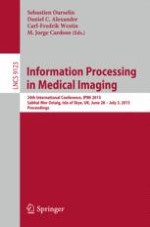2015 | Buch
Information Processing in Medical Imaging
24th International Conference, IPMI 2015, Sabhal Mor Ostaig, Isle of Skye, UK, June 28 - July 3, 2015, Proceedings
herausgegeben von: Sebastien Ourselin, Daniel C. Alexander, Carl-Fredrik Westin, M. Jorge Cardoso
Verlag: Springer International Publishing
Buchreihe : Lecture Notes in Computer Science
